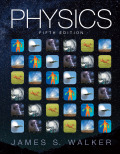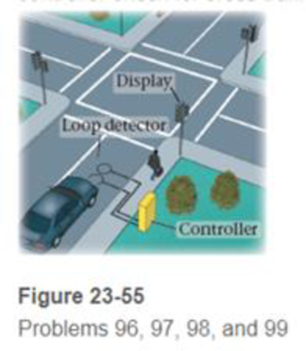
Concept explainers
Loop Detectors on Roadways
“Smart” traffic lights are controlled by loops of wire embedded in the road (Figure 23). These “loop detectors” sense the change in magnetic field as a large metal object—such as a car or a truck—moves over the loop. Once the object is detected, electric circuits in the controller check for cross traffic, and then turn the light from red to green.

A typical loop detector consists of three or four loops of 14-gauge wire buried 3 in. below the pavement. You can see the marks on the road where the pavement has been cut to allow for installation of the wires. There may be more than one loop detector at a given intersection; this allows the system to recognize that an object is moving as it activates first one detector and then another over a short period of time. If the system determines that a car has entered the intersection while the light is red, It can activate one camera to take a picture of the car from the front—to see the driver’s face—and then a second camera to take a picture of the car and its license plate from behind This red-light camera system was used to good effect during an exciting chase scene through the streets of London in the movie National Treasure Book of Secrets.
Motorcycles are small enough that they often fail to activate the detectors, leaving the cyclist waiting and waiting for a green light. Some companies have begun selling powerful neodymium magnets to mount on the bottom of a motorcycle to ensure that they are “seen” by the detectors.
•• Suppose a motorcycle increases the downward component of the magnetic field within a loop only from 1.2 × 10−5 T to 1.9 × 10−5 T. The detector is square, is 0.75 m on a side, and has four loops of wire. Over what period of time must the magnetic field increase if it is to induce an emf of 14 × 10−4 V?
- A. 0.028 s
- B. 0.11s
- C. 0.35 s
- D. 0.60 s
Want to see the full answer?
Check out a sample textbook solution
Chapter 23 Solutions
EBK PHYSICS
Additional Science Textbook Solutions
Laboratory Experiments in Microbiology (12th Edition) (What's New in Microbiology)
Chemistry (7th Edition)
Campbell Biology (11th Edition)
Anatomy & Physiology (6th Edition)
Human Anatomy & Physiology (2nd Edition)
Biology: Life on Earth with Physiology (11th Edition)
- pls help on thesearrow_forward20. Two small conducting spheres are placed on top of insulating pads. The 3.7 × 10-10 C sphere is fixed whie the 3.0 × 107 C sphere, initially at rest, is free to move. The mass of each sphere is 0.09 kg. If the spheres are initially 0.10 m apart, how fast will the sphere be moving when they are 1.5 m apart?arrow_forwardpls help on allarrow_forward
- 19. Mount Everest, Earth's highest mountain above sea level, has a peak of 8849 m above sea level. Assume that sea level defines the height of Earth's surface. (re = 6.38 × 106 m, ME = 5.98 × 1024 kg, G = 6.67 × 10 -11 Nm²/kg²) a. Calculate the strength of Earth's gravitational field at a point at the peak of Mount Everest. b. What is the ratio of the strength of Earth's gravitational field at a point 644416m below the surface of the Earth to a point at the top of Mount Everest? C. A tourist watching the sunrise on top of Mount Everest observes a satellite orbiting Earth at an altitude 3580 km above his position. Determine the speed of the satellite.arrow_forwardpls help on allarrow_forwardpls help on allarrow_forward
- 6. As the distance between two charges decreases, the magnitude of the electric potential energy of the two-charge system: a) Always increases b) Always decreases c) Increases if the charges have the same sign, decreases if they have the opposite signs d) Increases if the charges have the opposite sign, decreases if they have the same sign 7. To analyze the motion of an elastic collision between two charged particles we use conservation of & a) Energy, Velocity b) Momentum, Force c) Mass, Momentum d) Energy, Momentum e) Kinetic Energy, Potential Energyarrow_forwardpls help on all asked questions kindlyarrow_forwardpls help on all asked questions kindlyarrow_forward

 Physics for Scientists and Engineers, Technology ...PhysicsISBN:9781305116399Author:Raymond A. Serway, John W. JewettPublisher:Cengage Learning
Physics for Scientists and Engineers, Technology ...PhysicsISBN:9781305116399Author:Raymond A. Serway, John W. JewettPublisher:Cengage Learning Principles of Physics: A Calculus-Based TextPhysicsISBN:9781133104261Author:Raymond A. Serway, John W. JewettPublisher:Cengage Learning
Principles of Physics: A Calculus-Based TextPhysicsISBN:9781133104261Author:Raymond A. Serway, John W. JewettPublisher:Cengage Learning College PhysicsPhysicsISBN:9781938168000Author:Paul Peter Urone, Roger HinrichsPublisher:OpenStax College
College PhysicsPhysicsISBN:9781938168000Author:Paul Peter Urone, Roger HinrichsPublisher:OpenStax College Physics for Scientists and Engineers with Modern ...PhysicsISBN:9781337553292Author:Raymond A. Serway, John W. JewettPublisher:Cengage Learning
Physics for Scientists and Engineers with Modern ...PhysicsISBN:9781337553292Author:Raymond A. Serway, John W. JewettPublisher:Cengage Learning Glencoe Physics: Principles and Problems, Student...PhysicsISBN:9780078807213Author:Paul W. ZitzewitzPublisher:Glencoe/McGraw-Hill
Glencoe Physics: Principles and Problems, Student...PhysicsISBN:9780078807213Author:Paul W. ZitzewitzPublisher:Glencoe/McGraw-Hill





